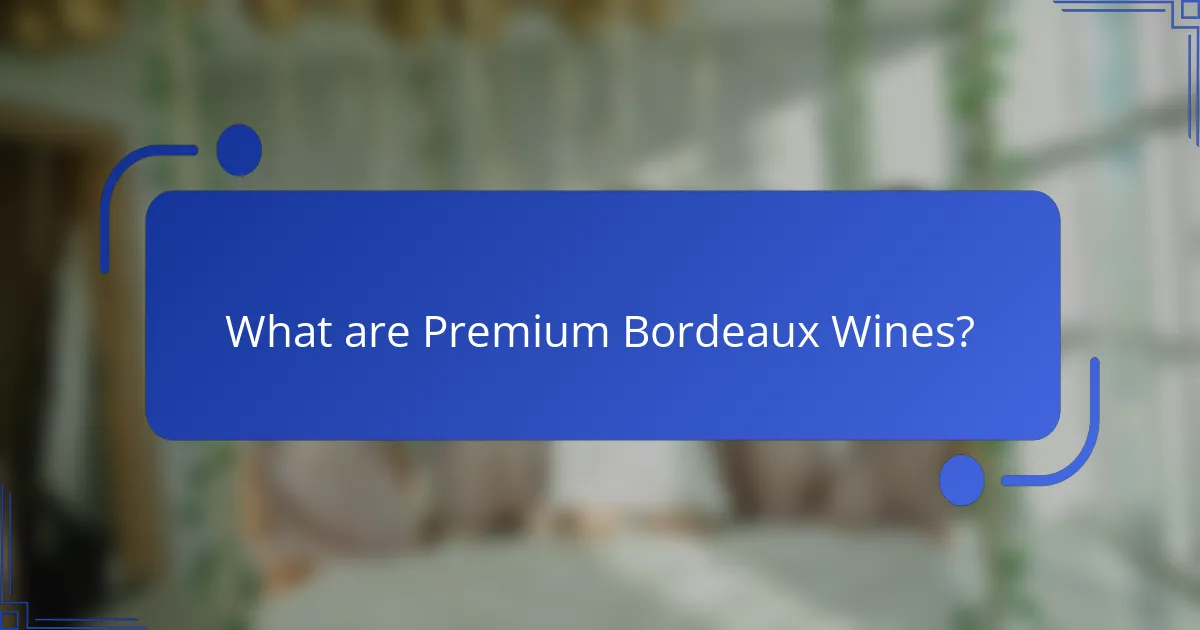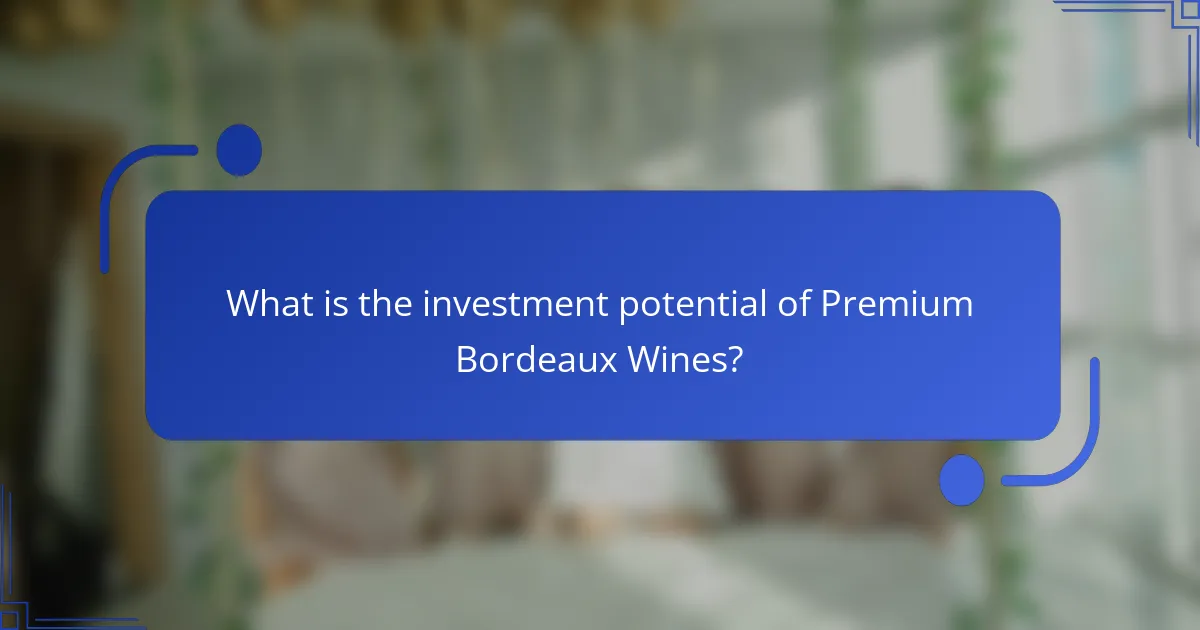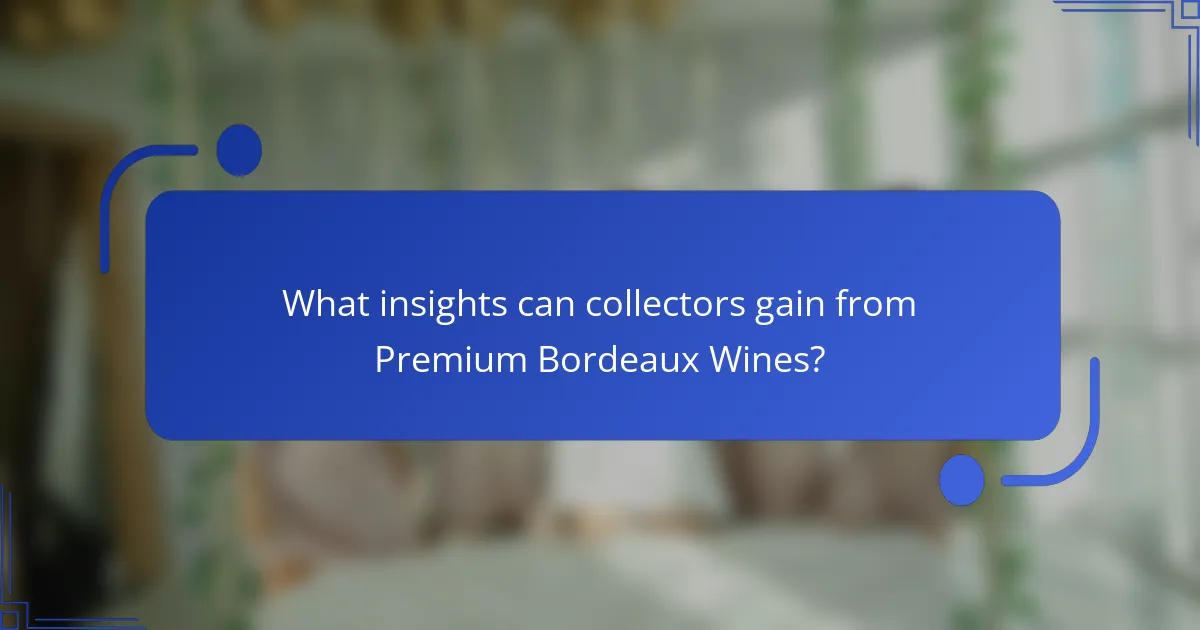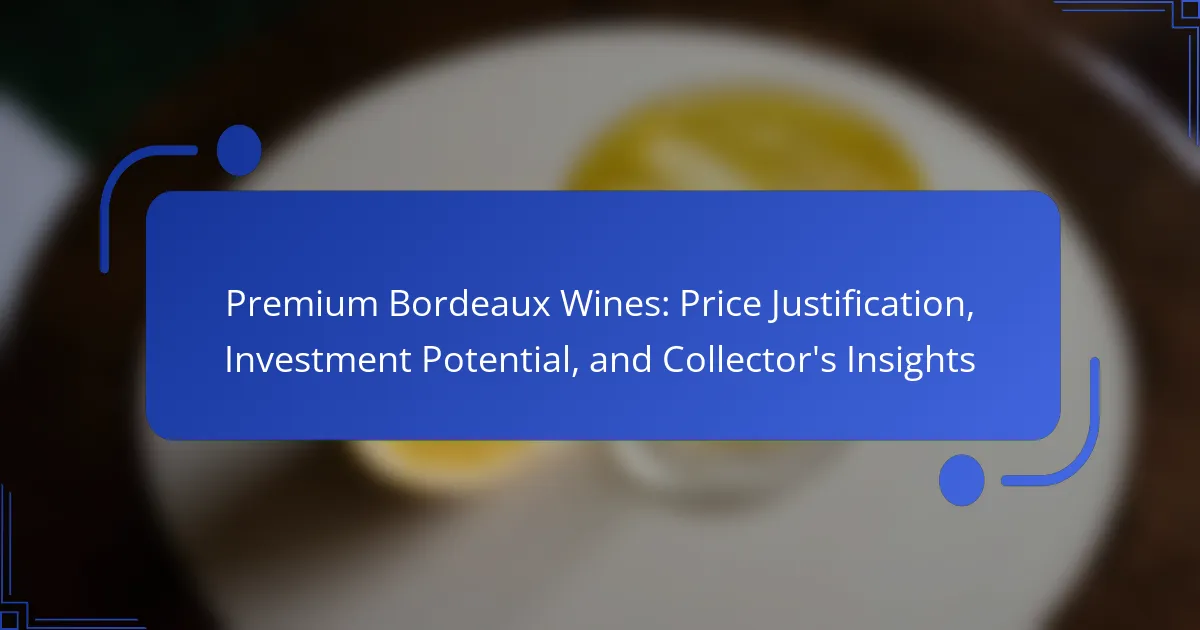
What are Premium Bordeaux Wines?
Premium Bordeaux wines are high-quality wines produced in the Bordeaux region of France. They are known for their exceptional taste, complexity, and aging potential. The classification system of Bordeaux wines includes categories such as Grand Cru and Premier Cru, which denote superior quality. These wines often feature grape varieties like Cabernet Sauvignon, Merlot, and Cabernet Franc. The terroir of Bordeaux contributes to the unique flavor profiles of these wines. Historical significance also adds to their premium status, with some estates dating back centuries. Collectors often seek these wines for investment due to their increasing value over time. The global demand for Premium Bordeaux wines further supports their market price.
How are Premium Bordeaux Wines classified?
Premium Bordeaux wines are classified primarily based on their quality and origin. The classification system includes several tiers, such as the 1855 Classification, which ranks wines from five growths (crus) based on reputation and price. Additionally, the Saint-Émilion classification is updated every ten years and includes Premier Grand Cru Classé and Grand Cru Classé designations. The Médoc and Graves regions also have their own classifications, emphasizing the unique terroirs of Bordeaux. These classifications are critical for investors and collectors, as they influence market value and desirability. The classifications are recognized globally, establishing Bordeaux’s reputation as a premier wine region.
What are the key characteristics of different Bordeaux wine classifications?
Bordeaux wine classifications include several key categories, each defined by specific criteria. The 1855 Classification ranks wines from the Médoc and Sauternes, categorizing them into five growths based on quality and price. First Growths, like Château Lafite Rothschild, represent the highest quality and command premium prices. The Cru Bourgeois classification includes wines that are not part of the 1855 system but are recognized for their quality, offering a more accessible price point. The Saint-Émilion classification is unique, as it is updated every 10 years and includes Premier Grand Cru Classé and Grand Cru categories based on quality and terroir. The Graves classification recognizes both red and white wines, emphasizing the region’s diverse offerings. Each classification reflects historical significance, quality, and market demand, influencing pricing and investment potential.
How does the region influence the classification of Bordeaux wines?
The region significantly influences the classification of Bordeaux wines. Bordeaux’s geographical location affects its climate, which is crucial for grape growing. The region’s soil types also vary, impacting the characteristics of the wines produced. Bordeaux is divided into distinct sub-regions, each with its own classification system. The Médoc, for instance, has its own Grand Cru classification. This classification is based on historical performance and reputation. The Right Bank and Left Bank regions produce different grape varieties, leading to varied wine styles. The classification system reflects these regional differences, guiding consumers and collectors in their choices.
Why are Premium Bordeaux Wines considered prestigious?
Premium Bordeaux wines are considered prestigious due to their exceptional quality and heritage. The Bordeaux region has a long history of winemaking, dating back to Roman times. The unique terroir, which includes climate and soil conditions, contributes to the distinct flavors and aromas of these wines. Renowned châteaux, such as Château Lafite Rothschild and Château Margaux, enhance the prestige through their reputation and consistent production of high-quality wines. Additionally, Bordeaux wines often receive high ratings from critics and wine connoisseurs, further solidifying their status. Limited production and aging potential create scarcity, driving demand among collectors and investors. The high prices of these wines reflect their esteemed position in the market. Overall, the combination of history, quality, and exclusivity establishes Bordeaux wines as symbols of luxury and prestige.
What historical factors contribute to the prestige of Bordeaux wines?
Bordeaux wines are prestigious due to their long history, quality production, and trade significance. The region has been producing wine since Roman times, establishing a rich heritage. Bordeaux’s classification system, created in 1855, ranked wines based on quality and price, enhancing their reputation. The region’s ideal climate and terroir contribute to the unique characteristics of its wines. Bordeaux wines gained international acclaim through trade with England and other countries, particularly in the 18th century. The establishment of wine merchants and brokers in Bordeaux further elevated its status. Additionally, historic events like the Phylloxera crisis led to innovations in viticulture. These factors collectively solidified Bordeaux’s position as a benchmark in the wine industry.
How do winemaking techniques impact the quality of Bordeaux wines?
Winemaking techniques significantly impact the quality of Bordeaux wines. Techniques such as grape selection, fermentation methods, and aging processes determine the final characteristics of the wine. Selecting high-quality grapes ensures better flavor and aroma profiles. Controlled fermentation temperatures enhance the extraction of color and tannins. Aging in oak barrels adds complexity and depth to the wine. Bordeaux wines often undergo malolactic fermentation, which softens acidity and improves mouthfeel. The use of specific yeast strains can influence the wine’s aromatic profile. Historical practices, such as blending different varietals, create balanced and harmonious wines. These techniques collectively contribute to the premium status and investment potential of Bordeaux wines.
What factors influence the pricing of Premium Bordeaux Wines?
The pricing of Premium Bordeaux Wines is influenced by several key factors. First, the reputation of the vineyard plays a significant role. Renowned vineyards like Château Lafite Rothschild command higher prices due to their historical prestige. Second, vintage quality affects pricing. Exceptional vintages, like 2005 or 2010, often see increased demand and higher prices. Third, supply and demand dynamics are crucial. Limited production quantities can drive prices up. Fourth, critical ratings and reviews from wine experts can elevate a wine’s market value. Wines receiving high scores from critics often sell at a premium. Fifth, regional factors, including terroir, contribute to pricing. The unique soil and climate conditions of Bordeaux enhance wine quality. Lastly, market trends and collector interest can influence prices. As trends shift, certain wines may gain popularity, impacting their market value.
How do vintage and terroir affect wine pricing?
Vintage and terroir significantly influence wine pricing. Vintage refers to the year the grapes were harvested. It affects quality and availability. Certain vintages are renowned for exceptional weather conditions. These conditions lead to higher quality grapes and, consequently, better wine. Terroir encompasses the unique environmental factors of a vineyard. It includes soil type, climate, and topography. Wines from prestigious terroirs often command higher prices. Collectors value these factors as they indicate potential for aging and investment. Historical auction results show that wines from top vintages and terroirs appreciate in value over time. For example, Bordeaux wines from the 2000 vintage are often priced higher due to their quality and reputation.
What role do brand reputation and rarity play in pricing?
Brand reputation and rarity significantly influence pricing in premium Bordeaux wines. A strong brand reputation enhances perceived value and consumer trust. This often leads to higher prices, as buyers are willing to pay a premium for recognized quality. Rarity contributes to exclusivity, making limited-production wines more desirable. When a wine is scarce, demand increases, which often drives prices higher. For instance, wines from renowned vintners like Château Lafite Rothschild command higher prices due to both their esteemed reputation and limited availability. Research indicates that wines with strong brand recognition can see price increases of up to 30% compared to lesser-known brands.

What is the investment potential of Premium Bordeaux Wines?
Premium Bordeaux wines have significant investment potential. Historical data shows that top Bordeaux wines appreciate in value over time. For example, the Liv-ex Fine Wine 100 index has reported consistent growth. In 2020, the index rose by 13.5%. This trend indicates strong demand among collectors and investors. Additionally, limited production and high ratings from critics enhance their value. Wines from renowned châteaux like Château Lafite Rothschild often fetch record prices at auctions. Furthermore, the global market for fine wines continues to expand, attracting new investors. Overall, Premium Bordeaux wines represent a viable investment opportunity.
How can Premium Bordeaux Wines be viewed as an investment?
Premium Bordeaux wines can be viewed as an investment due to their historical appreciation in value. The demand for these wines has consistently outpaced supply, especially for top vintages. According to Liv-ex, the fine wine market has shown an average annual return of 10.6% over the past decade. Specific vintages, such as Château Lafite Rothschild, have seen prices increase significantly, sometimes doubling within a few years. Additionally, Bordeaux wines are often considered a hedge against inflation, as tangible assets tend to retain value during economic downturns. The rarity of certain vintages further enhances their investment potential, making them attractive to collectors and investors alike.
What historical performance trends exist for Bordeaux wine investments?
Bordeaux wine investments have shown a consistent upward trend in value over the past few decades. Historical data indicates that the Liv-ex Bordeaux Index has increased by approximately 200% since 2000. Investment-grade Bordeaux wines typically appreciate in value due to limited supply and strong global demand. Notably, the 2005 vintage has been particularly successful, with prices rising significantly post-release. Additionally, economic factors, such as currency fluctuations and global market trends, have influenced Bordeaux wine prices. The performance of Bordeaux wines often correlates with the overall luxury goods market. This trend reflects the growing interest among collectors and investors in fine wines as alternative assets.
How do market demand and supply dynamics affect investment potential?
Market demand and supply dynamics significantly influence investment potential. When demand for premium Bordeaux wines increases, prices typically rise. This increase in price enhances the investment appeal of these wines. Conversely, if supply exceeds demand, prices may drop, reducing investment potential. Historical data shows that limited supply often correlates with higher prices. For instance, the 2010 Bordeaux vintage saw a surge in demand, leading to a 20% increase in prices within two years. Understanding these dynamics is crucial for investors aiming to maximize returns in the wine market.
What are the risks associated with investing in Premium Bordeaux Wines?
Investing in Premium Bordeaux Wines carries several risks. Market volatility can significantly affect wine prices. Economic downturns may reduce demand for luxury items like fine wine. Authenticity issues can arise, leading to potential fraud. Storage conditions impact wine quality and value over time. Additionally, lack of liquidity can make it difficult to sell investments quickly. Changes in consumer preferences may also affect the desirability of certain wines. Lastly, regulatory changes can impact wine investment markets. These factors collectively pose challenges for investors in this niche market.
How can market fluctuations impact the value of wine investments?
Market fluctuations can significantly impact the value of wine investments. The value of wine can rise or fall based on supply and demand dynamics. For example, economic downturns may lead to decreased consumer spending on luxury items like wine. This can result in lower prices for wine investments. Conversely, a strong economy can increase demand, driving prices higher.
Additionally, market trends, such as the popularity of certain wine regions, can affect valuations. For instance, a surge in interest for Bordeaux wines can elevate their market prices. Historical data shows that premium Bordeaux wines have experienced price volatility during economic shifts. According to the Liv-ex Fine Wine 100 index, fine wine prices can fluctuate by over 10% annually based on market conditions.
Investors must stay informed about market trends to make sound investment decisions. Understanding these fluctuations can help investors anticipate changes in wine values.
What should investors consider regarding storage and maintenance?
Investors should consider climate-controlled storage and proper maintenance for premium Bordeaux wines. Optimal conditions include consistent temperature between 50-57°F and humidity levels around 70%. Fluctuations can damage the wine’s quality. Additionally, bottles should be stored horizontally to keep corks moist. Regular inspection for signs of spoilage is essential. Proper storage prevents oxidation and preserves flavor. According to a study by the Wine Institute, improper storage can decrease wine value by up to 50%.
How can one assess the investment value of a specific Bordeaux wine?
To assess the investment value of a specific Bordeaux wine, one must evaluate several key factors. First, consider the wine’s provenance, which includes its origin and history. Wines with a strong, documented background typically hold higher value. Next, examine the wine’s ratings from reputable critics and wine publications. High ratings can significantly influence market demand and price.
Additionally, analyze market trends for the specific vintage. Historical performance data shows that certain vintages appreciate more than others. The wine’s storage conditions also matter; well-preserved bottles retain value better. Finally, consider the overall rarity of the wine. Limited production wines often command higher prices in the market.
These factors combined create a comprehensive assessment of a Bordeaux wine’s investment potential.
What criteria should be used to evaluate potential investment wines?
The criteria to evaluate potential investment wines include provenance, vintage quality, and market demand. Provenance refers to the wine’s history and authenticity. A wine with a well-documented origin typically has higher value. Vintage quality assesses the year of production. Certain years yield exceptional wines, impacting investment potential. Market demand reflects consumer interest and pricing trends. Wines from renowned regions or producers often experience greater demand. Additionally, condition and storage history are crucial. Properly stored wines maintain quality and value over time. These criteria collectively guide investors in making informed decisions about potential investment wines.
How do expert ratings and reviews influence investment decisions?
Expert ratings and reviews significantly influence investment decisions in premium Bordeaux wines. Investors often rely on these evaluations to assess the quality and potential value appreciation of specific wines. High ratings from reputable critics can lead to increased demand and higher prices in the market. According to a study by the University of California, wines rated 90 points or higher can see price increases of up to 20% within a year. Additionally, reviews provide insights into market trends and consumer preferences, guiding investors on which wines to acquire. The credibility of the reviewer also plays a crucial role; well-known critics can sway investor confidence and purchasing behavior.

What insights can collectors gain from Premium Bordeaux Wines?
Collectors can gain valuable insights from Premium Bordeaux Wines regarding market trends and investment potential. Bordeaux wines often appreciate in value over time, making them attractive assets. The historical performance of Bordeaux wines shows that top vintages can yield significant returns. For example, the Liv-ex Fine Wine 100 index indicates a consistent increase in value over the years. Additionally, understanding the characteristics of specific vintages helps collectors make informed purchasing decisions. Factors such as terroir, winemaking techniques, and aging potential are critical. Collectors can also benefit from knowing the reputation of châteaux and their production history. This knowledge aids in identifying wines that are likely to appreciate. Overall, insights from Premium Bordeaux Wines enhance collectors’ ability to navigate the wine market effectively.
How can collectors build a valuable Bordeaux wine collection?
Collectors can build a valuable Bordeaux wine collection by focusing on high-quality vintages and reputable producers. Selecting wines from renowned châteaux like Château Lafite Rothschild or Château Margaux ensures quality. Investing in wines from excellent vintages, such as 2000, 2005, or 2010, often yields better returns. Proper storage conditions are critical; maintaining a consistent temperature and humidity protects the wine’s integrity. Regularly assessing market trends helps identify wines with appreciating value. Engaging with wine auctions and reputable dealers can provide access to rare bottles. Networking with other collectors can also reveal valuable insights and opportunities. Collectors should document their collection for provenance, which enhances value over time.
What strategies can be employed to curate a diverse collection?
To curate a diverse collection of premium Bordeaux wines, collectors can employ several strategies. First, they should focus on sourcing wines from various regions within Bordeaux. This includes exploring the Left Bank and Right Bank, which offer distinct terroirs and grape varieties. Second, collectors should consider different vintages to capture the nuances of aging. Each vintage can exhibit unique characteristics based on weather conditions and winemaking techniques.
Additionally, including wines from lesser-known châteaux can enhance diversity. These wines often provide quality at lower price points compared to famous estates. Collectors should also explore a range of grape varieties, such as Cabernet Sauvignon, Merlot, and Petit Verdot. This variety can add depth to the collection.
Lastly, attending wine tastings and auctions can expose collectors to new wines and trends. Engaging with other collectors and experts can provide insights into emerging producers and regions. These strategies collectively foster a well-rounded and diverse Bordeaux wine collection.
How important is provenance in wine collecting?
Provenance is crucial in wine collecting. It establishes the history and authenticity of a wine. Provenance affects a wine’s value significantly. Wines with documented provenance often command higher prices. For instance, auction houses frequently emphasize provenance in their listings. A wine’s origin, storage conditions, and previous ownership influence its desirability. Collectors seek wines with verifiable histories to ensure quality. Therefore, strong provenance can enhance investment potential in premium Bordeaux wines.
What are the best practices for storing Premium Bordeaux Wines?
Store Premium Bordeaux Wines in a cool, dark, and humid environment. Ideal temperatures range from 50°F to 55°F. Maintain humidity levels between 50% and 80%. Use a wine cellar or a dedicated wine fridge for optimal conditions. Position bottles horizontally to keep corks moist. Avoid vibrations and store away from direct sunlight. Ensure consistent temperature to prevent spoilage. These practices help preserve the wine’s quality and enhance aging potential.
What environmental conditions are ideal for wine storage?
The ideal environmental conditions for wine storage include a consistent temperature of 55°F (13°C). This temperature helps preserve the wine’s quality. Humidity levels should be maintained at around 70%. This prevents corks from drying out and allows for proper sealing. The storage area should be dark, as UV light can degrade wine. Vibration should be minimized to avoid disturbing the sediment in the bottle. Additionally, wines should be stored horizontally to keep the cork moist. These conditions collectively ensure optimal aging and quality retention of wines.
How does proper storage affect the aging process of Bordeaux wines?
Proper storage significantly influences the aging process of Bordeaux wines. Optimal conditions include consistent temperature, humidity control, and protection from light. Bordeaux wines age best at temperatures between 50°F and 55°F. Fluctuations in temperature can lead to premature aging or spoilage. Humidity levels should be maintained around 70% to prevent cork drying. A dry cork can allow air to enter the bottle, causing oxidation. Additionally, exposure to light can degrade wine quality. Storing Bordeaux wines in a dark environment preserves their integrity. Studies indicate that proper storage can enhance the wine’s flavor development over time.
What tips can enhance the enjoyment of Premium Bordeaux Wines?
To enhance the enjoyment of Premium Bordeaux Wines, consider proper wine storage. Ideal conditions include a consistent temperature of 55°F. Humidity levels should be around 70% to prevent cork drying. Use appropriate glassware; Bordeaux glasses enhance aroma and flavor. Decanting the wine allows it to breathe and develop complexity. Pair the wine with complementary foods, such as red meats or aged cheeses. Serve at the correct temperature; red Bordeaux is best at 60-65°F. Finally, take time to savor the tasting experience, focusing on the wine’s aromas and flavors. These practices can significantly elevate the enjoyment of Premium Bordeaux Wines.
How should one approach tasting and pairing Premium Bordeaux Wines?
To approach tasting and pairing Premium Bordeaux Wines, begin by assessing the wine’s aroma and appearance. Look for clarity, color intensity, and viscosity. Swirl the wine gently in the glass to release its bouquet. Take a moment to inhale the scents, noting the complexity of aromas, which can include fruits, spices, and earthy notes.
Next, take a small sip to evaluate the wine’s flavor profile. Pay attention to the balance of sweetness, acidity, tannins, and alcohol. Premium Bordeaux wines often exhibit a range of flavors, from dark fruits to herbal undertones. Consider the wine’s finish, which should be long and pleasant.
For pairing, select foods that complement the wine’s characteristics. Rich, fatty dishes like beef or lamb pair well with the tannins in Bordeaux. Aged cheeses can also enhance the tasting experience. Consider the wine’s age as well; older wines may pair better with subtler flavors, while younger wines can handle bolder dishes.
Understanding the specific Bordeaux blend is crucial. For example, a Cabernet Sauvignon dominant blend pairs well with grilled meats, while a Merlot dominant blend complements poultry or pork dishes. Always experiment to discover personal preferences in pairings.
What common mistakes should collectors avoid when enjoying Bordeaux wines?
Collectors should avoid several common mistakes when enjoying Bordeaux wines. One mistake is not properly storing the wine. Bordeaux wines require specific temperature and humidity conditions for optimal aging. Another mistake is drinking the wine too early. Many Bordeaux wines benefit from aging, enhancing their flavor profiles over time. Additionally, collectors often overlook the importance of decanting. Decanting allows the wine to breathe and improves its taste. Ignoring the vintage is also a common error. Different vintages can significantly affect the quality of Bordeaux wines. Lastly, failing to research the wine’s provenance can lead to purchasing counterfeit bottles. Ensuring authenticity is crucial for collectors.
Premium Bordeaux wines are high-quality wines from the Bordeaux region of France, known for their exceptional taste, complexity, and aging potential. This article explores the classification systems of these wines, including Grand Cru and Premier Cru, and their key characteristics. It also examines the factors influencing pricing, investment potential, and the historical significance that contributes to their prestige. Additionally, insights for collectors on building valuable collections, proper storage practices, and tasting strategies are discussed, providing a comprehensive overview of the market dynamics surrounding Premium Bordeaux wines.
